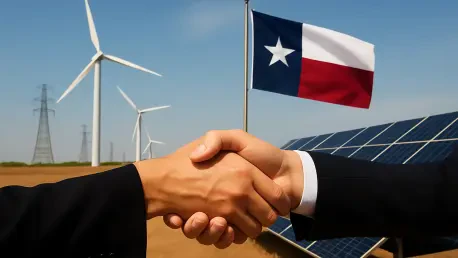In a state where energy demands are surging due to rapid population growth and economic expansion, Texas has taken a significant step to fortify its power grid with a substantial financial commitment. The recent approval of a $562 million low-interest loan to NRG Energy for the construction of a new 721-megawatt natural gas power unit near Baytown represents a critical move to ensure a stable electricity supply. Announced by Governor Greg Abbott, this loan is the largest disbursement yet under the Texas Energy Fund (TEF), a state initiative aimed at enhancing grid resilience after past crises exposed vulnerabilities. As electricity needs escalate with the proliferation of data centers and industrial growth, this investment signals a proactive approach to meeting future challenges. The focus on dispatchable power—energy that can be generated on demand—underscores the urgency of maintaining reliability in a region often tested by extreme weather and rising consumption patterns.
Strengthening Energy Infrastructure
The approval of this substantial loan through the TEF marks a pivotal moment in Texas’ ongoing efforts to bolster its energy infrastructure. Administered as a low-interest, 3% loan over 20 years, the funding supports NRG Energy in expanding the Cedar Bayou Generating Station, which currently operates at a 1,500-megawatt capacity with older units. The addition of a new natural gas unit will significantly enhance the station’s output, ensuring it can respond to peak demands and sudden shortages. Governor Abbott has highlighted this project as a cornerstone in positioning Texas as a global energy leader, emphasizing its role in sustaining both economic vitality and quality of life for residents. Beyond mere numbers, the initiative reflects a strategic vision to safeguard against the kind of grid failures seen in past emergencies, prioritizing stability in an era of increasing electrical dependency across residential, commercial, and industrial sectors.
This investment also carries broader implications for regional development and energy security in Texas. NRG Energy has underscored the project’s potential to create jobs and stimulate economic growth in the Baytown area, aligning energy policy with socioeconomic benefits. The focus on natural gas as a reliable, dispatchable power source addresses immediate grid needs, especially during high-stress periods like severe weather events. Matthew Pistner, NRG’s senior vice president of generation, noted that the expansion meets growing customer and state demands, reinforcing the company’s commitment to supporting Texas’ energy goals. While the $562 million loan offsets a significant portion of the $936 million total project cost, it also exemplifies how state-backed financial incentives can mitigate risks for private entities tackling large-scale infrastructure challenges, fostering a collaborative approach to solving systemic energy issues.
Addressing Rising Energy Demands
Texas faces a pressing need to keep pace with escalating electricity demands driven by population surges and technological advancements. The TEF, with over $7 billion in backing, was designed to incentivize the construction of natural gas power plants as a dependable solution, yet the rollout has been slower than anticipated, with only a handful of loans issued since its inception. The Cedar Bayou project stands out as a flagship effort to double the fund’s impact on power generation capacity, addressing forecasts that predict significant strain on the grid in the coming years. As data centers and industrial hubs multiply, the state must balance immediate needs with long-term planning, ensuring that energy supply does not falter under pressure. This loan serves as a tangible step toward meeting those challenges, prioritizing infrastructure that can deliver power when it’s most needed.
However, the path to grid reliability is not without hurdles, as global supply chain constraints for critical components like turbines drive up costs and cause delays in natural gas projects. In contrast, advancements in solar technology and battery storage offer more cost-effective alternatives, presenting a competitive landscape for energy development in Texas. While natural gas remains a cornerstone for dispatchable power, the state’s ability to integrate renewables into its energy mix could shape future strategies. The Cedar Bayou initiative, though focused on traditional energy, operates within this evolving context, highlighting the need for a diversified approach to meet rising demands. The state’s dual focus on supporting established energy sources while adapting to emerging trends suggests a nuanced effort to maintain grid stability amid complex market dynamics and technological shifts.
Future Steps for Grid Stability
Looking back, the decision to allocate a $562 million loan to NRG Energy marked a defining moment in Texas’ commitment to grid reliability. This strategic investment tackled immediate concerns by enhancing dispatchable power capacity at a critical juncture in the state’s growth. It also set a precedent for how state funds could bridge financial gaps for essential infrastructure projects, encouraging collaboration between public and private sectors. The emphasis on natural gas as a reliable energy source addressed past vulnerabilities, ensuring that lessons from previous grid crises were applied to prevent future disruptions.
Moving forward, Texas must accelerate the pace of similar initiatives while exploring complementary solutions to sustain its energy momentum. Streamlining the TEF loan distribution process could unlock additional capacity more quickly, while integrating renewable energy advancements offers a cost-effective way to diversify the grid. Policymakers and industry leaders should prioritize investments that balance short-term reliability with long-term sustainability, adapting to both technological innovations and shifting consumption patterns. The success of projects like Cedar Bayou could pave the way for a more resilient energy future, provided the state continues to navigate economic and logistical challenges with foresight and flexibility.









